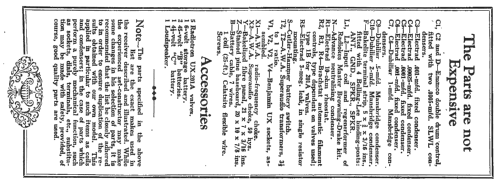Browning-Drake Four
Queensland Radio News, The; Brisbane, QLD
- Paese
- Australia
- Produttore / Marca
- Queensland Radio News, The; Brisbane, QLD
- Anno
- 1928
- Categoria
- Kit, scatola di montaggio (parti sfuse e istruzioni o solo istruzioni di montaggio)
- Radiomuseum.org ID
- 331749
Clicca sulla miniatura dello schema per richiederlo come documento gratuito.
- Numero di tubi
- 4
- Principio generale
- A reazione (con rigenerazione); A reazione (con rigenerazione)
- Gamme d'onda
- Solo onde medie (OM).
- Tensioni di funzionamento
- Batterie (di accumulatori e/o a secco) / 6 & 4½ & 2 x 45 Volt
- Altoparlante
- - Questo apparecchio richiede altoparlante/i esterno/i.
- Materiali
- Mobile in legno
- Radiomuseum.org
- Modello: Browning-Drake Four - Queensland Radio News, The;
- Forma
- Soprammobile a cassapanca o cassetta, solitamente con coperchio (NON a leggio)
- Annotazioni
-
The Queensland Radio News version of the Browning-Drake four valver.
Unique among four valve circuits, is the Browning-Drake, in that it is the only circuit in this class which has stood the test of time, and emerged, four years after it was first published, with undiminished popularity. There is no doubt in the minds of those who are familiar with the various types of multi-valve sets that the Browning-Drake Four is easily the equal of many five-valve arrangements, and there is a very good reason for its splendid performance
Glen H. Browning and F. H. Drake, both Harvard University men, and originators of the circuit which bears their name, set out on their experiments with a definite object in view. Their ambition was to design a receiver using a single stage of radio frequency amplification and valve rectifier, and to increase the operating efficiency of this combination to a point which had not hitherto been approached.
A radio-frequency transformer was designed mathematically in which the windings were so proportioned and disposed that a very large transfer of energy was obtainable without the amplifier becoming unstable. This transformer was later designated the "Regenerformer" (a combination of the two words "regeneration" and "transformer"), and may be described as the foundation of the Browning-Drake receiver. To ensure a high degree of stability in the RF amplifier, this valve is neutralised, while additional amplification almost equal to that provided by a second RF stage is due to the use of regeneration or reaction in the detector circuit; this reaction, it should be noted, is at all times under perfect control. The Queensland Radio News, June 1, 1928, Page 7.lnput coil (L1) and Regenerformer (L2) are supplied by Radiokes in the Master Browning Drake kit
- Bibliografia
- -- Original prospect or advert (The Queensland Radio News, June 1, 1928, Page 7)
- Autore
- Modello inviato da Gary Cowans. Utilizzare "Proponi modifica" per inviare ulteriori dati.
- Altri modelli
-
In questo link sono elencati 1 modelli, di cui con immagini e con schemi.
Elenco delle radio e altri apparecchi della Queensland Radio News, The; Brisbane, QLD




